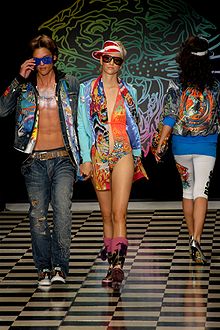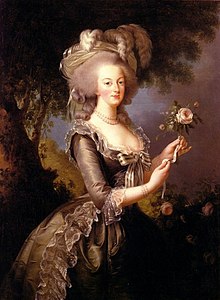Fashion
From Wikipedia, the free encyclopedia that anyone can edit
Fashion, a general term for the style and custom prevalent at a given time, in its most common usage refers to costume or clothing style. The more technical term, costume, has become so linked in the public eye with the term "fashion" that the more general term "costume" has in popular use mostly been relegated to special senses like fancy dress or masquerade wear, while the term "fashion" means clothing generally, and the study of it. This linguistic switch is due to the fashion plates which were produced during the Industrial Revolution, showing the latest designs.[citation needed] For a broad cross-cultural look at clothing and its place in society, refer to the entries for clothing, costume and fabrics. The remainder of this article deals with clothing fashions in the Western world.[1]
Contents[hide] |
[edit]Clothing fashions
For detailed historical articles by period, see History of Western fashion
The continually changing fashions of the West have been generally unparalleled either in antiquity or in the other great civilizations of the world until recent decades. Early Western travellers, whether toPersia, Turkey, Japan or China frequently remark on the absence of changes in fashion there, and observers from these other cultures comment on the unseemly pace of Western fashion, which many felt suggested an instability and lack of order in Western culture. The Japanese Shogun's secretary boasted (not completely accurately) to a Spanish visitor in 1609 that Japanese clothinghad not changed in over a thousand years.[2] However in Ming China, for example, there is considerable evidence for rapidly changing fashions in Chinese clothing.[3]
Changes in costume often took place at times of economic or social change (such as in ancient Rome and the medieval Caliphate), but then a long period without large changes followed. This occurred in Moorish Spain from the 8th century, when the famous musician Ziryab introduced sophisticated clothing styles based on seasonal and daily timings from his native Baghdad and his own inspiration to Córdoba, Spain.[4][5] Similar changes in fashion occurred in the Middle East from the 11th century, following the arrival of the Turks who introduced clothing styles from Central Asiaand the Far East.[6]
The beginnings of the habit in Europe of continual and increasingly rapid change in styles can be fairly reliably dated to the middle of the 14th century, to which historians including James Laver andFernand Braudel date the start of Western fashion in clothing.[7][8] The most dramatic manifestation was a sudden drastic shortening and tightening of the male over-garment, from calf-length to barely covering the buttocks, sometimes accompanied with stuffing on the chest to look bigger. This created the distinctive Western male outline of a tailored top worn over leggings or trousers.
The pace of change accelerated considerably in the following century, and women and men's fashion, especially in the dressing and adorning of the hair, became equally complex and changing.Art historians are therefore able to use fashion in dating images with increasing confidence and precision, often within five years in the case of 15th century images. Initially changes in fashion led to a fragmentation of what had previously been very similar styles of dressing across the upper classes of Europe, and the development of distinctive national styles, which remained very different until a counter-movement in the 17th to 18th centuries imposed similar styles once again, finally those from Ancien Régime in France.[9] Though the rich usually led fashion, the increasing affluence of early modern Europe led to the bourgeoisie and even peasants following trends at a distance sometimes uncomfortably close for the elites - a factor Braudel regards as one of the main motors of changing fashion.[10]
Ten 16th century portraits of German or Italian gentlemen may show ten entirely different hats, and at this period national differences were at their most pronounced, asAlbrecht Dürer recorded in his actual or composite contrast of Nuremberg and Venetian fashions at the close of the 15th century (illustration, right). The "Spanish style" of the end of the century began the move back to synchronicity among upper-class Europeans, and after a struggle in the mid 17th century, French styles decisively took over leadership, a process completed in the 18th century.[11]
Though colors and patterns of textiles changed from year to year,[12] the cut of a gentleman's coat and the length of his waistcoat, or the pattern to which a lady's dress was cut changed more slowly. Men's fashions largely derived from military models, and changes in a European male silhouette are galvanized in theatres of European war, where gentleman officers had opportunities to make notes of foreign styles: an example is the "Steinkirk" cravat or necktie.
The pace of change picked up in the 1780s with the increased publication of French engravings that showed the latest Paris styles; though there had been distribution of dressed dolls from France as patterns since the 16th century, and Abraham Bosse had produced engravings of fashion from the 1620s. By 1800, all Western Europeans were dressing alike (or thought they were): local variation became first a sign of provincial culture, and then a badge of the conservative peasant.[13]
Although tailors and dressmakers were no doubt responsible for many innovations before, and thetextile industry certainly led many trends, the history of fashion design is normally taken to date from 1858, when the English-born Charles Frederick Worth opened the first true haute couture house in Paris. Since then the professional designer has become a progressively more dominant figure, despite the origins of many fashions in street fashion. The four major current fashion capitalsare acknowleged to be Milan, New York City, Paris, and London. Fashion weeks are held in these cities, where designers exhibit their new clothing collections to audiences, and which are all headquarters to the greatest fashion companies and are renowned for their major influence on global fashion.
Modern Westerners have a wide choice available in the selection of their clothes. What a person chooses to wear can reflect that person'spersonality or likes. When people who have cultural status start to wear new or different clothes a fashion trend may start. People who like or respect them may start to wear clothes of a similar style.
Fashions may vary considerably within a society according to age, social class, generation, occupation, and geography as well as over time. If, for example, an older person dresses according to the fashion of young people, he or she may look ridiculous in the eyes of both young and older people. The terms fashionista or fashion victim refer to someone who slavishly follows the current fashions.
One can regard the system of sporting various fashions as a fashion language incorporating various fashion statements using a grammar of fashion. (Compare some of the work of Roland Barthes.)
[edit]Media
An important part of fashion is fashion journalism. Editorial critique and commentary can be found in magazines, newspapers, on television, fashion websites, social networks and in fashion blogs.
At the beginning of the 20th century, fashion magazines began to include photographs or (PicS) and became even more influential than in the past. In cities throughout the world these magazines were greatly sought-after and had a profound effect on public taste. Talented illustrators drew exquisite fashion plates for the publications which covered the most recent developments in fashion and beauty. Perhaps the most famous of these magazines was La Gazette du Bon Ton which was founded in 1912 by Lucien Vogel and regularly published until 1925 (with the exception of the war years).
Vogue, founded in the US in 1892, has been the longest-lasting and most successful of the hundreds of fashion magazines that have come and gone. Increasing affluence after World War IIand, most importantly, the advent of cheap colour printing in the 1960s led to a huge boost in its sales, and heavy coverage of fashion in mainstream women's magazines - followed by men's magazines from the 1990s. Haute couture designers followed the trend by starting the ready-to-wearand perfume lines, heavily advertised in the magazines, that now dwarf their original couture businesses. Television coverage began in the 1950s with small fashion features. In the 1960s and 1970s, fashion segments on various entertainment shows became more frequent, and by the 1980s, dedicated fashion shows like Fashion-television started to appear. Despite television and increasing internet coverage, including fashion blogs, press coverage remains the most important form of publicity in the eyes of the industry.
However, over the past several years, fashion websites have developed that merge traditional editorial writing with user-generated content. New magazines like Runway Magazine, who is lead by Nole Marin from America's Next Top Model, have begun to dominate the digital market with digital copies for computers, iphones and iPads.
Sporting a different view, a few days after the 2010 Fall Fashion Week in New York City came to a close, Fashion Editor Genevieve Tax said, "Because designers release their fall collections in the spring and their spring collections in the fall, fashion magazines such as Vogue always and only look forward to the upcoming season, promoting parkas come September while issuing reviews on shorts in January." "Savvy shoppers, consequently, have been conditioned to be extremely, perhaps impractically, farsighted with their buying."[14]
[edit]Intellectual property
Within the fashion industry, intellectual property is not enforced as it is within the film industry and music industry. To "take inspiration" from others' designs contributes to the fashion industry's ability to establish clothing trends. Enticing consumers to buy clothing by establishing new trends is, some have argued, a key component of the industry's success. Intellectual property rules that interfere with the process of trend-making would, on this view, be counter-productive. In contrast, it is often argued that the blatant theft of new ideas, unique designs, and design details by larger companies is what often contributes to the failure of many smaller or independent design companies.
In 2005, the World Intellectual Property Organization (WIPO) held a conference calling for stricter intellectual property enforcement within the fashion industry to better protect small and medium businesses and promote competitiveness within the textile and clothing industries.






No comments:
Post a Comment